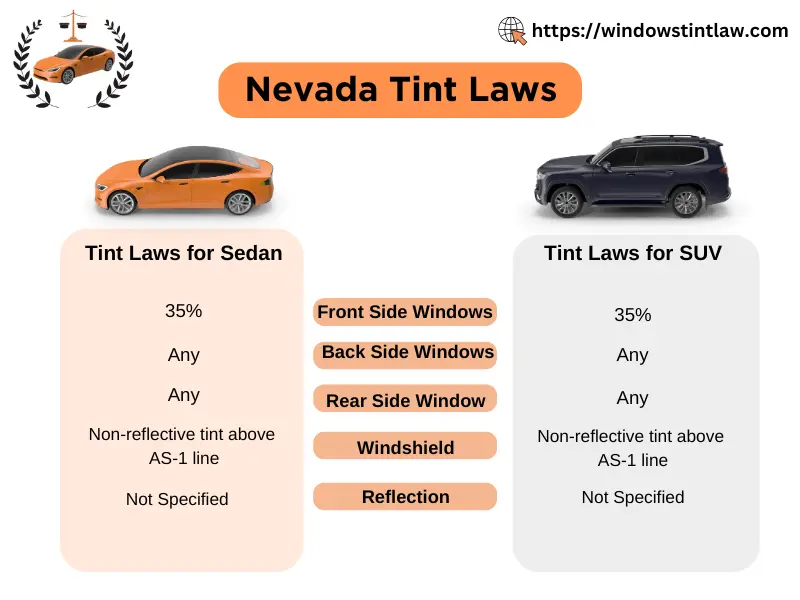Nevada Tint Laws were legislated in 1993 to make roads safer for everyone. Illegal tint may cause personal injury to vehicle occupants in an event of accident.
Tinted windows are beneficial and protects from harmful UV rays emitted from the sun, on the other side window tinting may put you in trouble. Police or law enforcement agencies may catch the drivers with illegal tints, Hence drivers should verify the legal tint is installed.
Vehicle owners or drivers must know the allowed Visible Light percentages for all window types, to avoid tint tickets. We have provided the complete details of Nevada window tinting laws in terms of tint darkness, tint reflection and restricted tint colors.
If you are living in any other state, you can check Window tinting rules of your state.
Overview of Nevada Tint Laws
The below image outlines the Nevada tinting laws for Cars and Trucks. Tint darkness and tint reflection limits are provided below.

Darkest Legal Tint in Nevada
Window tint darkness and tint reflection limitation for Cars and SUVs are given in below table. The percentage refers to Visible Light Transmission percentage, which is directly proportional to darkness of tint. The lesser the light passes through film, more darker will be tint.
| State | Front Side Windows | Back Side Windows | Rear Windows | Windshield | Tint Reflection | Color Tints |
| Nevada | 35% | Any | Any | Non Reflective Tint above the AS1 line. | Not specified in State laws. | Red and amber color tints are not allowed. |
Drivers and owners of the vehicles must obey these rules to avoid penalties.
Window Tint Reflection
Front windshield must be covered with Non reflective tint above the AS-1 Line, but solar reflectance for side windows and rear window is not specified in the state laws. For clear understanding of exact limits, vehicle operators can consult with nearest DMV office or kiosk.
However Glass coating materials with reflective properties are not recommended to install, as they produce glare from sunlight or headlights. The Glare may cause inconvenience for other drivers and passengers on road.
Other Rules and Regulations
There are some other rules for vehicle with tinted windows, which are required to be followed.
- Dual Side Mirrors: Both side mirrors are necessary, if the rear window is covered with tinting or coating material.
- Restricted Tint Colors: Red and Amber Tint colors are prohibited.
- Sticker: Drivers or vehicle owners are not required to display label or sticker to identify the legal tint is applied.
- Certificate: Window Film Manufacturers should get the certificate for window film they sell in the Nevada.
Medical Exemption
Nevada Tint laws allow individuals for a tint waiver due to specific medical conditions. Licensed physician or optometrist or Dermatologist usually certify the medical condition, which requires to get shielded from direct sunrays. Any applicant should submit the application for window tint exemption to Nevada Highway Patrol, Department of Public Safety.
After getting Tint waiver, The approved documents or copy of Exemption certificate must be carried in vehicle at all the times.
Penalties for Violating Nevada Tint Laws
If any individual caught with illegal tint, police can test tinted windows using tint meter. If found illegal, violator can get a tint ticket of value upto $100 in the first offense. Cops can also ask to remove the illegal tint coating applied to motor vehicle.
Repeated offenses will cost you more fine, so it is recommended to follow the tint laws and avoid inconvenience.
These window tinting rules are applicable in all cities and counties in Nevada including but not limited to Las Vegas, Henderson and Reno.
